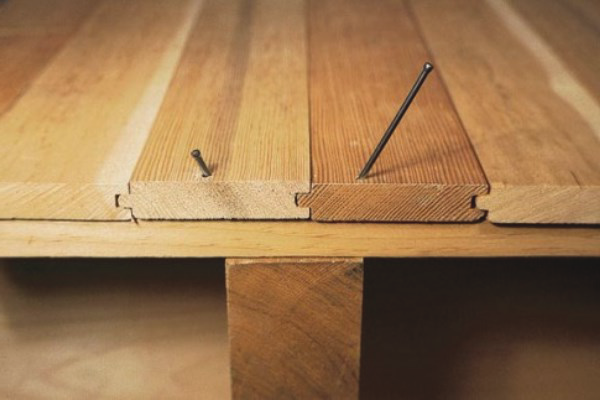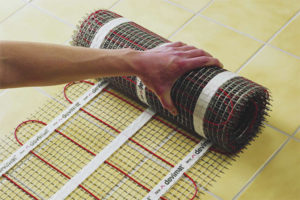The content of the article
Creaking wooden floorboards annoying and makes you nervous? At night, you can not go to the toilet without waking all family members? An unpleasant sound occurs due to the deformation of the wood, which eventually shrinks. Formed gaps between the boards and lags or baseboards, they rub against each other and creak. Sometimes the nails or support bars are to blame, so the fight with a squeak begins with a careful study of the flooring.
Oxidative processes
Boards are smooth and elastic, without cracks and dents? Do not bend when walking? The source of noise can be nails, which fixed the board during installation. Metal parts are rusty, reduced in volume and deformed, and wood that held them in place loses its strength and collapses. The nail is loosened and moves, making unpleasant sounds.
Rusty metal mounts replace the screws. Details are screwed at a distance of 4-5 mm from the nail head. For each creaking board, take at least 2 screws to securely fix it. The new fixture is screwed into the wood together with the cap, so that it does not interfere with moving around the room. Old nails are pulled with pliers or a nail puller.
Reliable fixation
Do metal caps protrude and sit firmly in place? The reason for the noise in the boards themselves, which rub against lags. If the apartment is built of dense concrete slabs, the squeak is removed with anchors. Suitable zabivny and wedge variants or core clamps.
You will need a drill, which make a hole in the creaking board and the support bar. A concrete is drilled using a perforator, and then an anchor is inserted into it and the nut is tightened to fix it. Fasteners are mounted around the perimeter of the room at a distance of 1 m or more.
The creaking disappears for a long time if the anchor is used correctly, but the method itself is rather expensive.
Foam and wedge
Do the boards bend and make a distinctive sound? You will need foam and drill.Drill a hole in the creaking wood. Insert the tip of the can into it and extrude the foam. Use the low secondary expansion option to prevent deformation of the boards.
Squeeze a small amount of foam, wait until the filler hardens. Do not put furniture on the board or step on it. After drying, remove the remaining foam, cover the hole.
Mounting foam lasts for 1-3 years depending on the location of the board. If the floorboard is often attacked, the filler quickly settles, and the creaking again appears.
Beginners who have not previously worked with such materials may fill the void in half or pour in more foam than necessary. The lack of filler, as well as its excess, leads to the deformation of the floorboard. The board is blown up in several places or cracked, and you have to replace it.
Wood in the autumn-winter season absorbs moisture and swells. In summer, the liquid evaporates, the board dries out and decreases in volume. After 2–4 years, small gaps form between the floorboards, due to which the creaking appears.
You will need a thin wooden lath, which is ground at one end. It turns cone wedge.The workpiece is applied to the gap, it should be 1–2 mm wider.
Carpenter glue is applied to the sharp end and a wedge is inserted into the slot. Hammer the rail with a mallet or a regular hammer wrapped in a towel. The case is not strong, so as not to deform the wood. Wait for the glue to dry completely.
The protruding part of the rack is cut with a plane or a pointed ax, ground and covered with a putty. Paint is applied to the wedge so that it does not stand out against the floor.
Baby powder or graphite talc is poured into small gaps. The material protects wooden elements from friction and removes unpleasant sound.
The gaps between the boards are filled with a special paste, which consists of:
- sawdust - 4 parts;
- paint for wooden floors - 1 part;
- transparent varnish - 1 part.
Stir the ingredients until smooth, spread with a spatula or thin stick over the entire gap, tightly tamping the mass. Smooth out the paste, wait until it dries. Sand protruding areas, paint over.
Alternative paste composition: sawdust and glue. Prepare a thick paste from the components, cover up the cracks.
Uniting the floorboards
Multiple gaps are formed between the old boards made of low-quality wood. One wedge is not enough to get rid of squeak. We'll have to remove the boards and re-lay.
First, remove the plinth and gently remove the nails, trying not to damage the wood. Dusty or deformed floorboards are thrown away, whole copies are put aside. The first board, located next to the wall, is left in place. It is not necessary to remove the floor throughout the room, you can start from one side.
The floorboard is laid on the logs and pushed to the main board with wooden wedges. The details are tapped with a mallet so that there are no gaps between the grooves. The hole, which will appear after the removal and re-laying of old boards, is covered with a new floorboard. It should be 4–5 mm wider than the gap.
The detail is attached to logs by self-tapping screws. The last stage is the installation of a new plinth and painting the floor.
Jewelry work
Even quality wood is destroyed over time. The cause of the strain can be insects, rot, high loads. When one or more floorboards squeak, it makes no sense to change all the boards.It is enough to remove the damaged part and insert a new part.
The deformed area is surrounded by a pencil or a marker. It will take a drill of small diameter, with which several holes are made in the floorboard. They are needed to separate the rotten part from the floor and not damage the adjacent boards.
The drill is set aside and take a chisel. To hold the tool at an angle of 45 degrees. With the help of a hammer, hollow out the rotten part of the floorboard. The parameters of the new insert should match the size of the hole. The board is sharpened from the inside to make cone-shaped edges.
Wood glue is applied to the wood, the hole is closed and the bar is fixed with screws. The protruding edges are cut with a plane, then the wooden patch is ground and painted. If the work is done correctly, the floorboard ceases to creak.
Sound insulation layer
Do the boards fit tightly into the logs? Wood quality and without damage? There are no gaps between the parts and even small cracks, but the boards continue to creak? There are two options: completely replace the floor or lay a plywood board over the wooden base.The second method takes less time and finances.
Buy only high-quality and dense plates. Thickness from 12 mm and more. The wooden base must be leveled, otherwise not only floorboards, but also the upper layer will creak.
Take plywood out of the package before use and fold it out so that the sheets dry out. Take out the furniture to another room, clean the floor from debris, vacuum and wash. The material should be laid in a staggered manner, retreating from the walls of 1.5–2 cm. It is impossible that the joints of sheets lying side by side intersect.
Before fastening plywood spread on the floor and mark the location of each piece. Then the parts are glued to the wooden boards and wait for them to dry. For insurance, sheets are fixed with self-tapping screws 4–5 cm long. The fastener is screwed into the plate along with the caps. Between the screws comply with a step of 20 cm.
Large sheets of plywood are divided into 2 or 4 parts to minimize the deformation of the material when exposed to moisture. Between the plates must leave technological gaps.
New floor
Owners of old apartments with rotten or rotten boards are recommended to relocate the floor.The process is long and costly, but sometimes there is no other way out.
When installing new boards on a concrete base stack insulation. The space between the supporting beams is filled with drywall, expanded clay or mineral wool. The material performs a waterproofing function and prevents the accumulation of excess moisture in the wood. These are preventive measures that protect floorboards from deformation and squeaking.
Natural boards, made of wood, look good and expensive. But wood wears faster than marble, stone and linoleum. To protect the pine or oak floor from deformation, ventilation systems are installed in the rooms and air humidity is monitored. Wood, which is regularly taken care of, collapses more slowly and for a long time “is silent”, without a single squeak.
Video: how to eliminate the creak of a wooden floor












To send